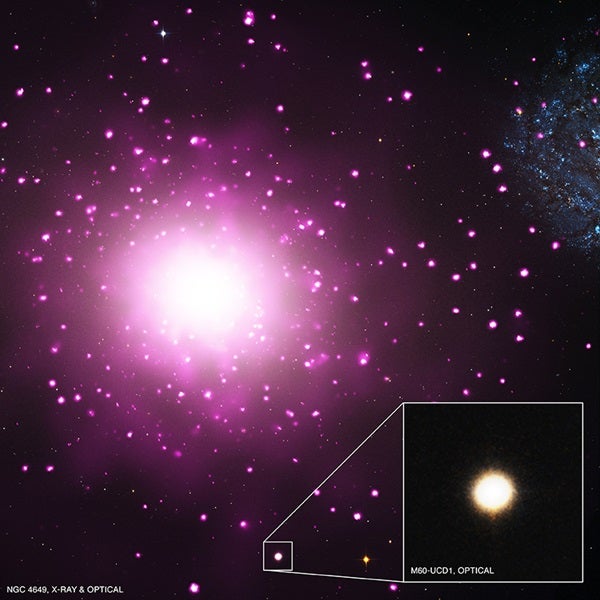The ultra-compact dwarf galaxy M60-UCD1 is packed with an extraordinary number of stars and may be the densest galaxy near Earth. It is providing astronomers with clues to its intriguing past and its role in the galactic evolutionary chain.
M60-UCD1, estimated to be about 10 billion years old, is near the massive elliptical galaxy M60 that is about 54 million light-years from Earth. It is the most luminous known galaxy of its type and one of the most massive, weighing 200 million times more than our Sun, based on observations with the W. M. Keck Observatory 10-meter telescope in Hawaii.
What makes M60-UCD1 so remarkable is that about half of this mass is found within a radius of only about 80 light-years. The density of stars is about 15,000 times greater — meaning the stars are about 25 times closer to each other — than in Earth’s neighborhood in the Milky Way Galaxy.
“Traveling from one star to another would be a lot easier in M60-UCD1 than it is in our galaxy, but it would still take hundreds of years using present technology,” said Jay Strader of Michigan State University in Lansing.
The 6.5-meter Multiple Mirror Telescope in Arizona was used to study the amount of elements heavier than hydrogen and helium in stars in M60-UCD1. The values were found to be similar to our Sun.
“The abundance of heavy elements in this galaxy makes it a fertile environment for planets and, potentially, for life to form,” said Anil Seth of the University of Utah.
Another intriguing aspect of M60-UCD1 is the presence of a bright X-ray source in its center, revealed in Chandra data. One explanation for this source is a giant black hole weighing in at about 10 million times the mass of our Sun.
Astronomers want to find out whether M60-UCD1 was born as a jam-packed star cluster or became more compact as stars were ripped away from it. Large black holes are not found in star clusters so if the X-ray source is, in fact, due to a massive black hole, it was likely produced by collisions between M60-UCD1 and one or more nearby galaxies. M60-UCD1’s great mass and the abundances of elements heavier than hydrogen and helium are also arguments for the theory it is the remnant of a much larger galaxy.
“We think nearly all of the stars have been pulled away from the exterior of what once was a much bigger galaxy,” said Duncan Forbes of Swinburne University in Australia. “This leaves behind just the very dense nucleus of the former galaxy and an overly massive black hole.”
If this stripping did occur, then the galaxy originally was 50 to 200 times more massive than it is now and the mass of its black hole relative to the original mass of the galaxy would be more like that of the Milky Way and many other galaxies. The stripping could have taken place long ago and M60-UCD1 may have been stalled at its current size for several billion years.










